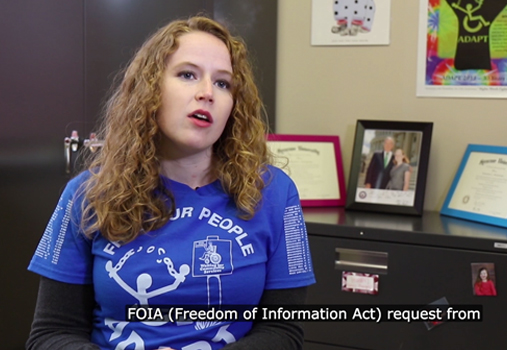Shatter your complacency
By Katie Johnson

Advocate Stephanie Woodward startled her interviewer in the film Bottom Dollars by revealing that some workers with disabilities earn just two cents an hour.
I thought I understood the issue of employment for people with disabilities, until I watched Bottom Dollars, a new documentary from Rooted in Rights and filmmaker Jordan Melograna, which revealed to me how little I actually knew.
The film will likely have the same revelatory effect on you – should you attend a free showing of Bottom Dollars at UD’s Center for Disabilities Studies on Nov. 4 at noon. And don’t be surprised if the film spurs you to action, making you want to do something about the outrageous and extensive injustices it exposes that affect people with disabilities in the workplace far too frequently.
I’d long known that people with disabilities are often devalued, discouraged and exploited at their jobs. In restrictive sheltered workshops, they’re assigned menial tasks that fail to make use of their unique skills and talents. But this fact from the film, made me sick: Some earn as little as 50 cents an hour. That’s what James Meadours says he was making at his first job in Oklahoma. Stephanie Woodward, the director of advocacy at Disability Rights Washington in Rochester, NY, reported in the film that through a Freedom of Information Act request, she found that Good Will pays some of its workers with disabilities two cents – two cents! – an hour.
Advocates for people with disabilities in the film place much of the blame for this abuse of employees with disabilities on the perpetuation of a subminimum wage in 48 states that encourages companies to pay select workers less than the societal minimum, simply because they have a disability.
How do they get away with paying so little? The Fair Labor Standards Act of 1938, which set a revolutionary minimum wage guarantee, unfortunately also included Section 14(c), which makes it legal to pay people with disabilities a subminimum wage.
Almost 80 years later, things need to change.
- We need to phase out sheltered workshops, begun in the 1950s and 1960s, that originally were intended to be places for vocational training but that today promote segregation. Low expectations from the public, matched with legal business incentives, keep alive these workhouses that lead to disastrous outcomes for people with disabilities.
- We need to see that more people with disabilities have individualized transition plans, which, as the film demonstrates, allow them to perform with pride jobs in the community that fit their skills.
- We need to do away with the subminimum wage. New Hampshire did so in July of 2015. Maryland did so in May of 2016. What’s keeping Delaware? What’s keeping the other 47 states? Subminimum wages are discriminatory and pronounce that people with disabilities are subhuman and deserve to live in poverty forever.
Everything’s not bleak. The film shows how some communities are providing supports that increase chances businesses will provide integrated employment opportunities to people with disabilities. They’re not doing that as charity, but rather because they understand that people with disabilities benefit a community. As employees, they’re overwhelmingly hardworking, dedicated and productive.
Still, huge steps need to be taken.
I encourage you to come watch Bottom Dollars, and let it shatter your complacency, the way it shattered mine.
Categories: accessibility, authentic community integration, Center for Disability Studies, civil rights, community living, employment, inclusion, people with disabilities, public policy, sheltered workshops, subminimum wage, Uncategorized
Tags: Bottom Dollars, Fair Labor Standards Act, Good WIll, individualized transition plans, Rooted in Rights, sheltered workshops, subminimum wage.

